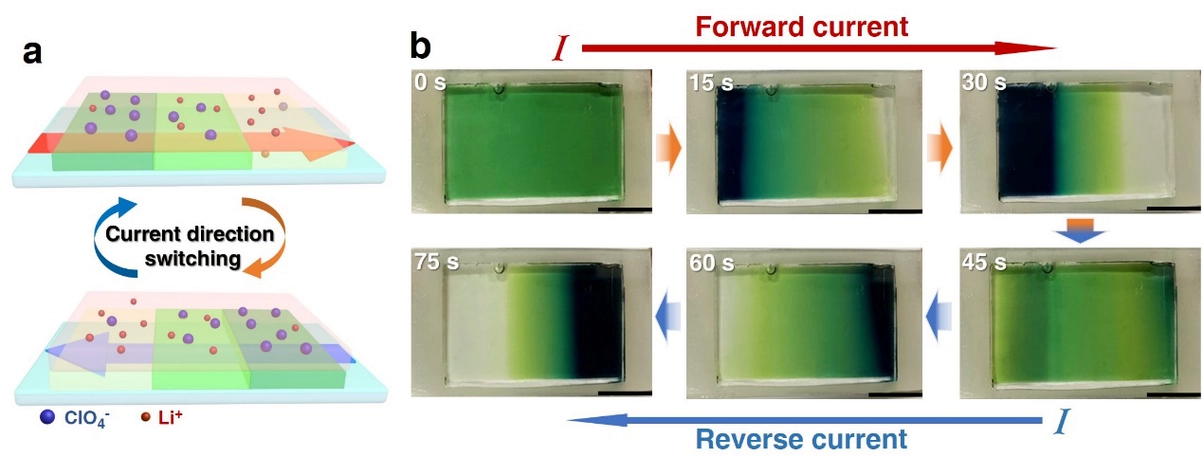Smart glass coating could cool glass buildings.

Fraunhofer researchers have developed a smart coating for glass windows that darkens in sunlight. This uses electrochromic and thermochromic materials that react to electricity and heat. In buildings with large glass facades, it prevents rooms from becoming overheated by solar radiation, reducing the need for energy-intensive air conditioning.
The construction industry is one of the largest emitters of greenhouse gases. According to the German Environment Agency, buildings account for about 30% of the country’s CO2 emissions and 35% of its energy consumption. Buildings with large glass facades and roofs are particularly problematic, such as the office towers that dominate modern cities. They can get hot in the sun, especially in the summer. However, the use of blinds and blinds to provide shading is generally frowned upon as they reduce the aesthetics of the glass and interfere with the view to the outside. Instead, the interior is cooled using air conditioning, which requires large amounts of electricity and increases the building's carbon footprint.
The Fraunhofer Institute for Silicates ISC in Würzburg and the Fraunhofer Institute for Organic Electronics, Electron Beam, and Plasma Technology FEP in Dresden have developed a complex solution to address this question. In the Switch2Save project, researchers have been studying clear coatings for windows and glass facades using electrochromic and thermochromic materials. These add a variable, transparent dark tint to the outside of the window, keeping the room cool. The Fraunhofer Institute has collaborated with university and industrial partners in six EU countries on this EU-funded research project.
The electrochromic coating is applied to a transparent conductive film, which can then be "turned on." Applying a voltage triggers the transfer of ions and electrons, darkening the coating and tinting the window. Thermochromic coatings, on the other hand, work by reflecting the sun's thermal radiation when a certain ambient temperature is reached, explains Dr. Marco Schott, group manager for electrochromic systems at Fraunhofer ISC.
With electrochromic elements, sensors can be used to measure factors such as brightness and temperature and send the results to a control system. This sends a current or voltage pulse to the conductive film, triggering the window to darken. Whenever the temperature or brightness becomes too high, the glass surface gradually darkens. This prevents rooms from overheating and reduces the need for air conditioning, which is particularly useful in sunny climates and buildings with large glass facades. It also acts as anti-glare protection on sunny days. On cloudy days and at night, the windows will remain bright.
The Fraunhofer researchers also considered whether the technology would be suitable for everyday use. The windows don't darken suddenly, but gradually over a few minutes, and Short explains that energy consumption is very low. In the best case, electrochromic films require electricity only during the conversion process, with very low voltages sufficient to initiate the coloring process. Thermochromic materials require no electricity at all, instead reacting passively to heat generated by the sun. They can be used to complement switchable systems or as an alternative where a switchable solution is not required.
Switch2Save promises significant energy savings in areas with high outdoor temperatures (i.e. the South) by reducing the use of air conditioning systems or eliminating the need for them. Dr. John Fahlteich, Switch2Save project coordinator and research group leader at Fraunhofer FEP, explains that in warmer regions of Europe, the cooling and heating energy needs of modern buildings can be reduced by up to 70%. In cooler northern regions, the cost savings are not huge, but the system can also be used here as anti-glare protection against direct sunlight.
In principle, the combination of electrochromic and thermochromic layers in composite windows offers the greatest possible flexibility. By using it, architects and developers can provide individual solutions for various areas and buildings. We are installing the technology in a pediatric clinic at the second-largest hospital in Athens, Greece, and in an office building in Uppsala, Sweden. In both buildings, energy consumption will be monitored and compared for a full year before and after the new windows are installed. By doing this, we can demonstrate the real-world performance of Switch2Save technology and can continue to test and improve the technology for different climate zones, Fahlteich said.
The researchers also addressed manufacturing challenges. Electrochromic coatings are applied to polymer-based film substrates. Thermochromic coatings, on the other hand, use thin glass substrates. Wet chemical and vacuum coating processes are used for economical roll-to-roll manufacturing systems. The switchable components are then laminated under vacuum to 4mm thick window glass, which is then integrated into the insulating glass unit. The coating process is also economically feasible on an industrial scale. Electrochromic and thermochromic switchable elements are only a few hundred microns thick, weighing less than 500 grams per square meter. As a result, they add virtually no weight to the windows, meaning they can be retrofitted into existing buildings without changing the building structure.
Video 1 The Fraunhofer ISC Electrochromic System 1
The project consortium is currently working on further improving the technology. For example, a team of experts is investigating how to combine electrochromic and thermochromic elements in composite windows to better exploit the technology's potential. Further research goals include adapting the coating to curved glass forms and adding more colors to the existing blue and gray options.
A warming world and the goals of the European Green Deal will significantly increase demand for energy-efficient building technologies in the coming years – all buildings in the EU are expected to be carbon neutral by 2050. The EU's Switch2Save project for electrochromic and thermochromic windows can make an important contribution to this.
Disclaimer: The above views do not represent the position of LIJIANG Glass, and the copyright belongs to the original author and source. The content of News is the author's personal opinion, and it does not mean that LIJIANG Glass agrees with his opinion and is responsible for its authenticity. LIJIANG Glass only provides references and does not constitute investment and application advice.



